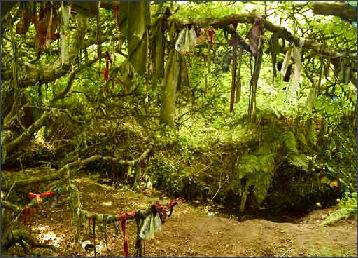Madron
OS grid ref:- SW 4531
 The village of Madron is situated to the north of the town of Penzance and boasts superb views of Mounts Bay and St.Michael's Mount.
The village of Madron is situated to the north of the town of Penzance and boasts superb views of Mounts Bay and St.Michael's Mount.
Madron holds the distinction of being the first English settlement to hear the news of the death of Vice Admiral Horatio Nelson following the Battle of Trafalgar in 1805. HMS Pickle was coming up the Western Approaches, the fishing fleet from Penzance greeted the ship and the sad news of Nelson's death in the battle was related. A fishing vessel passed the news to the shore at Madron which was formally announced from the balcony of the Assembly Rooms, now the Union Hotel, in Chapel Street. Madron's church was the first church in England to toll its bells on the occasion, and every year since, they are rung in remembrance.
The village church is dedicated to St. Madron, variously spelt Maddarne, Madern and Madran, a sixth century Breton missionary and hermit of Cornish descent who appears in Cornish and Welsh literature. St. Madron was associated with cures of physical ailments. The church font survives from an earlier Norman church which stood on the site. St. Madron's church was once owned by the Knights Hospitallers of Jerusalem.
Of ancient origins, Madron is mentioned in the Domesday Book of 1086, there are 8 stone crosses in the area of the village, one of which stands in the churchyard and another is at Heamoor.
To the north of the village, on the West Cornwall moors, are several prehistoric sites including Chun Castle, Men-Scryfa, Men-an-Tol, Boswens Standing Stone and Lanyon Quoit.
Madron Holy Well
OS grid ref- SW 445327
 In woods between and the village of Madron and the rocky outcrop of Madron Carn, lies a ruined chapel and an ancient holy well.
In woods between and the village of Madron and the rocky outcrop of Madron Carn, lies a ruined chapel and an ancient holy well.
Madron Holy Well is an example of a Cornish Celtic sacred site, which is renowned for its healing properties.
A tradition at this site persists to this day whereby people attach pieces of rag (clouties) to the nearby bushes as a symbol of appeasement to the spirits within the well site. A nearby tree is festooned with colourful strips of cloth and bangles. The branches of the tree shade a circular pool, which has an underground spring emerging at one end.
Until the onset of the eighteenth 18th century Madron Well was the only source of water for Madron and Penzance.
Madron Ancient Chapel
The nearby ancient moss covered chapel stands roofless. The doorway faces to the north, an unusual practice in Christian churches as it is sometimes considered the Devil's Door. Inside is a small raised dais with a stone altar. At the opposite corner of the building is a baptistry, or well-head, with steps going down to an enclosure where water bubbles up from the same underground source as the holy well.
The chapel dates to the twelfth century, but occupies much older site of pagan religious site, St Madern is often considered a Christianised corruption of the Celtic mother goddess Modron.
There are many stories of healing are associated with the well and chapel. One such refers John Trelille, who lived in the twelfth century. Trelille was paralysed from the waist down. He bathed three times in the well, and each time spent the night on St Maddern's Bed. AThe story goes on to relate that he was 'cured' of his paralysis. Trelille's cure was verified by the Bishop of Exeter after an enquiry, and the subsequent publicity brought flocks of pilgrim's to Madron throughout the medieval period.